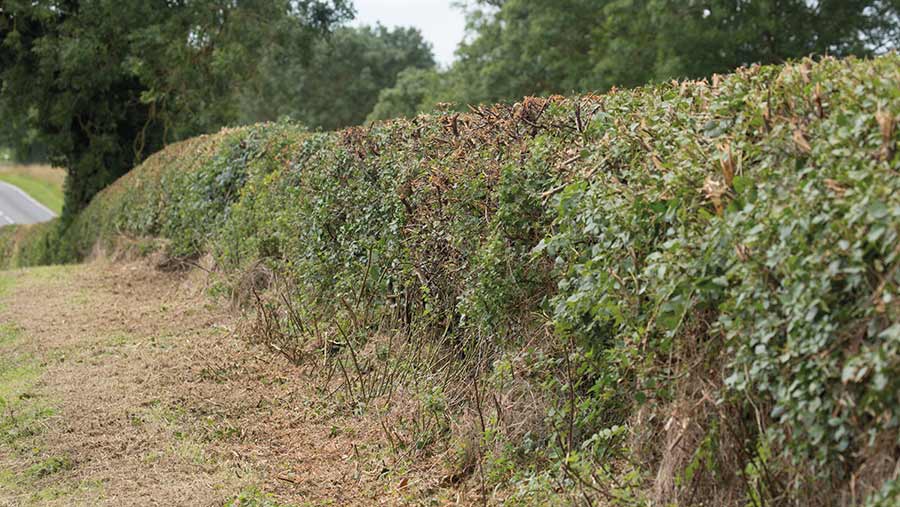Business Clinic: Can I make a field entrance through hedge?
 © Tim Scrivener
© Tim Scrivener Whether you have a legal, tax, insurance, management or land issue, Farmers Weekly’s Business Clinic experts can help.
Nicola Quick, planning expert at Carter Jonas, advises on whether a hedge can be removed to create a new field entrance
See also: Business Clinic – what can we do about compulsory purchase?
Q. I would like to create a new field entrance. This would be dug through the hedge bank and across a few metres of unused ground to reach an existing farm track, which is also a bridleway.
I own all the ground concerned including the track and it is in a national park. There are some changes in level but it is all easily achievable with a small digger.
Am I entitled to carry out this work without transgressing any planning legislation?
A. This is an interesting question but I’m afraid the likely answer is no. I am assuming this is a new entrance on to a track between two fields.
If it is a new entrance on to a classified road, a planning application would definitely be required.
Countryside hedgerows are protected under The Hedgerow Regulations 1997, which prohibit the removal of most countryside hedgerows without first notifying the local planning authority.
There are specific criteria to determine if the hedgerow is protected under these rules relating to its length, location and importance.
Length – it is protected if it is:
- More than 20m long with gaps of 20m or less along its length
- Less than 20m long, but meets another hedge at each end.
Location – it is protected if, among other things, it is on or adjacent to “land used for agriculture or forestry”.
Importance – it is protected if it is at least 30 years old and meets one of the following criteria:
- Marks all or part of a parish boundary that existed before 1850
- Contains an archaeological feature such as a scheduled monument
- Is completely or partly in or next to an archaeological site listed on a Historic Environment Record (HER), (formerly a Sites and Monuments Record)
- Marks the boundary of an estate or manor or looks to be related to any building or other feature that is part of the estate or manor that existed before 1600
- Is part of a field system or looks to be related to any building or other feature associated with the field system that existed before 1845 – you can check the County Records Office for this information
- Contains protected species listed in the Wildlife and Countryside Act 1981
- Contains species that are endangered, vulnerable and rare and identified in the British Red Data books
- Includes woody species and associated features as specified in Schedule 1, Part II Criteria, paragraph 7(1) of the Hedgerow Regulations – the number of woody species needed to meet this criteria is one fewer in northern counties.
You can find more information about these criteria for hedgerow regulation and management on the government website.
Apply to National Park Authority
In your circumstances, you would have to make an application to the National Park Authority providing details of the section of hedge you wish to remove.
After acknowledgement they will have 42 days to respond.
They will consult your parish council, so I would recommend you speak to them beforehand about your proposal.
The outcome will result in either a hedgerow retention notice (i.e. it must be kept) or a written notice giving you permission to remove it.
You will have up to two years from the date of the written notice to undertake the works.
There are some additional points to consider.
If consent is given for you to proceed, you need to ensure the bridlepath is not obstructed during the works.
If permitted, you will need to consider whether your works will harm nesting birds or destroy nests. If so, you should undertake the work outside the main nesting and breeding season (1 March to 31 August).
You will need to check that none of the trees within the hedgerow is protected by a Tree Preservation Order.
If you are felling trees, check whether you require a felling licence.
Finally, if your land is within a stewardship agreement, you need to consider if it impacts on any of your obligations. If so, you will need to notify the Rural Payments Agency.
The extension of the track could fall under your permitted development rights, alternatively a planning application would be required.
Note – if you were not in a national park, using your agricultural permitted development rights for the track would prevent you using your Class Q permitted development rights for 10 years.
However, the Class Q rights do not apply in national parks, as they are covered under article 2(3) land in national planning guidance.
Do you have a question for the panel?
Outline your legal, tax, finance, insurance or farm management question in no more than 350 words and Farmers Weekly will put it to a member of the panel. Please give as much information as possible.
Email your question to FW-Businessclinic@markallengroup.com using the subject line “Business Clinic”.
